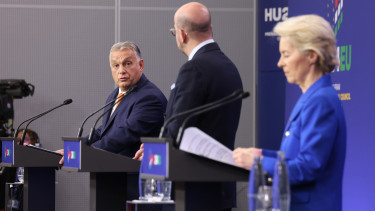Disappearing pandemic eliminates Hungarians' remaining want for COVID-19 jabs
Fortunately, following hospitalisation and ventilation figures, Covid death statistics have also started to reflect the petering out of the fifth wave in the coronavirus pandemic.

How to read the following chart?
On the two charts below the 0% line is important. When the curves are under 0% there’s a decline, when they go over 0% it’s an increase.
More importantly, when a value is north of 0% but the curve descends, it means an increase at a slowing rate, rather than a decrease. If the curve is above 0% and ascending, it is an increase at an accelerating rate. When we are under 0% and the curve goes lower, it translates into an accelerating decrease, and when it goes up it marks a decelerating decrease.



In this wave, between 1 August and 1 March, 14,107 Hungarians died of coronavirus-related diseases, which compares with 14,591 in the same period a year earlier when only about 132,000 people were protected by two doses of COVID-19 vaccine (14 days after 2nd shot).
Note that excess mortality statistics (released by the Central Statistical Office, KSH) paint a more accurate picture of the severity of the coronavirus pandemic than the numbers published by the coronavirus task force, but due to constant revisions the final (or close to final) mortality data will not be available for the period under review at least until late March.

When István György, state secretary in charge of public affairs at the Prime Minister's Office, previously shared information about the weekend vaccination campaigns, it seemed that he (they) calculated with four days (Thursday to Sunday) instead of three (Thursday to Saturday). For your convenience and to avoid any misunderstanding about the ‘success’ of the vaccination campaign, we have collected data for three and also for four days.
If you are not a numbers person, just ignore the tables and look at the charts.
First, let’s see the figures for the ‘weekends’ in February, both for three days (Thursday to Saturday) and for four days (Thursday to Sunday).
Demand for third doses dropped more than for first and second shots combined, as a result of which the distribution of 3rd and 1st+2nd doses is now basically even.


And this is how demand for COVID-19 shots changed from one weekend to another in February (Thursday-Saturday).



And this is how demand for COVID-19 shots changed from one weekend to another in February (Thursday-Sunday).

And now let's see January and March together. The trendlines for three days (Thursday-Saturday) clearly show a huge drop in the number of third doses administered, and the trend for 1st and 2nd shots combined is also descending.
 The trend is practically the same for four days (Thursday-Sunday).
The trend is practically the same for four days (Thursday-Sunday).


Key data on vaccination in Hungary
A couple of important facts about Hungary's vaccination status:
- nearly 3.34 million Hungarians (34.3%) of the population have not received a single dose of any COVID-19 vaccine'
- vaccination helps avoid infection and effectively prevents severe disease and death;
- two doses provide seriously diminished effectiveness against infection by Omicron;
- about 3.81 million Hungarians (39.2% of the population) are vaccinated with three doses of COVID-19 vaccines;
- more than 5.73 million Hungarians got their 2nd jab more than four months ago;
- on the wild assumption that all of the 3rd doses were administered to members of the above group, there are still about 1.92 million people in that group that have not received their third jab;
- 1,922,000 Hungarians received their 3rd dose more than four months ago and 1,806,000 more than five months ago.







